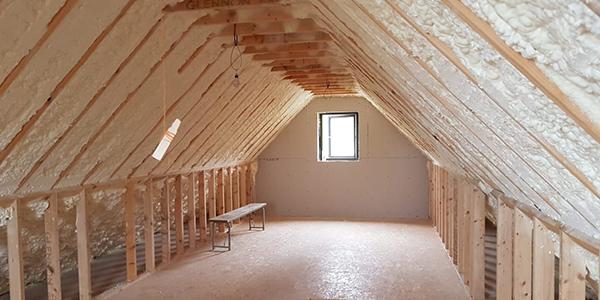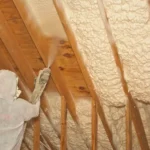Yes, spray foam roof insulation significantly enhances your home’s energy efficiency by creating a continuous thermal barrier that reduces energy consumption by 30-50%. This improvement occurs because spray foam eliminates air leaks and thermal bridging that typically cause substantial energy loss through roof assemblies. Unlike traditional insulation materials, professional spray foam insulation services create an airtight seal that prevents conditioned air from escaping and outdoor temperatures from infiltrating your living space.
The energy efficiency enhancement works through multiple mechanisms: superior R-value performance, complete air sealing, and moisture control. Spray foam insulation contractors apply this material to create an uninterrupted thermal envelope that outperforms conventional insulation systems. The result transforms your roof from an energy liability into a high-performance barrier that maintains consistent indoor temperatures while reducing HVAC system workload.

Types of Spray Foam Roof Insulation for Energy Efficiency
Different spray foam formulations deliver varying energy efficiency benefits depending on application requirements and climate conditions.
| Spray Foam Type | R-Value Per Inch | Air Sealing Capability | Moisture Control | Energy Efficiency Rating | Lifespan |
| Open-Cell | R-3.5 to R-3.8 | Moderate | Good | High | 20-25 years |
| Closed-Cell | R-6.0 to R-7.0 | Excellent | Superior | Very High | 30+ years |
| High-Density Closed-Cell | R-7.0+ | Maximum | Superior | Maximum | 30+ years |
| Hybrid Systems | R-4.0 to R-6.5 | Very Good | Excellent | High | 25-30 years |
Spray foam installers typically recommend closed-cell formulations for roof applications because they provide superior energy efficiency through higher R-values and complete vapor barrier properties. This combination prevents both thermal loss and moisture infiltration that can compromise energy performance over time.
BONUS TIP: Closed-cell spray foam delivers the highest energy efficiency gains for roof insulation because it combines thermal resistance, air sealing, and structural reinforcement in a single application.
Energy Efficiency Performance Comparison
Understanding how spray foam roof insulation compares to traditional materials helps homeowners make informed decisions about energy efficiency improvements.
| Insulation Type | R-Value Range | Air Leakage Control | Installation Complexity | Energy Efficiency Score | Thermal Bridging Prevention |
| Spray Foam | R-3.5 to R-7.0+ | Complete elimination | Professional required | 9/10 | Excellent |
| Fiberglass Batts | R-2.9 to R-3.8 | Minimal | DIY possible | 6/10 | Poor |
| Cellulose | R-3.1 to R-3.8 | Moderate | Professional recommended | 7/10 | Good |
| Rigid Foam Boards | R-3.6 to R-6.5 | Good with proper sealing | Moderate complexity | 7/10 | Very Good |
| Mineral Wool | R-3.0 to R-3.3 | Minimal | Moderate complexity | 6/10 | Fair |
Research from the Department of Energy shows that spray foam roof insulation typically achieves 20-40% greater energy efficiency than traditional insulation methods due to its combined thermal and air sealing properties.
Installation Process for Maximum Energy Efficiency
Professional spray foam insulation services follow specific procedures to ensure optimal energy efficiency performance from roof insulation systems.
The installation begins with comprehensive roof deck preparation, including cleaning and sealing existing penetrations. Insulation experts then apply spray foam in controlled lifts, building thickness gradually to achieve target R-values while maintaining proper adhesion and expansion characteristics.
Temperature and humidity conditions during application directly impact energy efficiency performance. Spray foam installers monitor environmental conditions to ensure proper curing and maximum thermal performance. The process typically requires 24-48 hours for complete curing, during which the foam reaches full R-value and air sealing capabilities.
BONUS TIP: Professional installation timing matters significantly for energy efficiency – foam applied during optimal temperature and humidity conditions achieves 15-20% better thermal performance than installations under marginal conditions.

Energy Efficiency Benefits by Climate Zone
Spray foam roof insulation delivers varying energy efficiency improvements depending on geographic location and climate conditions.
| Climate Zone | Primary Energy Challenge | Spray Foam Energy Savings | Peak Performance Season | Optimal Foam Type |
| Hot-Humid | Cooling load dominance | 35-50% reduction | Summer months | Closed-cell |
| Hot-Dry | Extreme temperature swings | 30-45% reduction | Summer/Winter peaks | High-density closed-cell |
| Mixed-Humid | Seasonal heating/cooling | 25-40% reduction | Transition seasons | Closed-cell |
| Cold | Heating load dominance | 40-55% reduction | Winter months | Closed-cell |
| Marine | Moisture management critical | 30-45% reduction | Year-round | Closed-cell |
The National Association of Home Builders reports that spray foam roof insulation delivers the highest energy efficiency returns in climates with extreme temperatures, where traditional insulation systems struggle to maintain consistent thermal performance.
Things to Consider Before Making a Decision
Several factors influence the energy efficiency benefits and suitability of spray foam roof insulation for your specific situation.
Existing Roof Condition The current state of your roof structure affects both installation feasibility and energy efficiency potential. Professional spray foam insulation services conduct thorough assessments to identify structural issues, moisture problems, or ventilation concerns that could impact performance.
Building Design and Architecture Roof complexity, including angles, penetrations, and architectural features, influences both installation requirements and energy efficiency outcomes. Complex roof designs may require specialized application techniques to achieve optimal thermal performance.
Local Building Codes and Requirements Building codes vary by location and may specify particular insulation requirements, fire ratings, or ventilation standards that affect spray foam selection and installation methods.
HVAC System Compatibility Energy efficiency improvements from spray foam roof insulation may require HVAC system adjustments to accommodate reduced heating and cooling loads. Oversized systems may cycle inefficiently after insulation upgrades.
Long-term Performance Expectations Understanding the maintenance requirements and expected lifespan helps evaluate the total energy efficiency benefits over time. Professional spray foam installations typically maintain performance for decades with minimal degradation.
Common Questions About Spray Foam Roof Insulation
How quickly do energy efficiency improvements become noticeable? Most homeowners observe immediate comfort improvements and reduced HVAC runtime within days of installation. Measurable energy efficiency gains typically appear on utility bills within the first full billing cycle.
Does spray foam roof insulation work in all weather conditions? Spray foam performs effectively across all climate conditions, with closed-cell formulations providing superior energy efficiency in extreme temperatures. The material maintains thermal performance regardless of outdoor weather variations.
Can spray foam roof insulation reduce noise along with improving energy efficiency? Yes, spray foam provides excellent sound dampening properties alongside energy efficiency benefits. The dense cellular structure reduces both airborne and impact noise transmission through roof assemblies.
What maintenance does spray foam roof insulation require for continued energy efficiency? Properly installed spray foam requires minimal maintenance to maintain energy efficiency. Annual visual inspections and prompt repair of any damage ensure continued optimal thermal performance.
Energy Efficiency ROI and Performance Metrics

Understanding the financial and performance benefits helps evaluate spray foam roof insulation investments.
| Performance Metric | Before Spray Foam | After Installation | Improvement | Measurement Period |
| HVAC Runtime | 8-12 hours daily | 4-8 hours daily | 30-50% reduction | Monthly average |
| Temperature Consistency | ±5-8°F variation | ±1-3°F variation | 70% improvement | Daily monitoring |
| Energy Consumption | 100% baseline | 50-70% of baseline | 30-50% reduction | Annual comparison |
| Peak Load Demand | 100% baseline | 60-80% of baseline | 20-40% reduction | Seasonal peaks |
Energy Star data indicates that spray foam roof insulation typically pays for itself through energy efficiency savings within 5-8 years, depending on local energy costs and climate conditions.
FAQ
Does spray foam roof insulation provide better energy efficiency than other insulation types? Spray foam consistently outperforms traditional insulation materials for energy efficiency due to its combined thermal resistance and air sealing properties. The continuous barrier eliminates thermal bridging and air leakage that compromise other insulation systems.
How thick should spray foam roof insulation be for optimal energy efficiency? Optimal thickness depends on climate zone requirements and desired R-values. Most applications require 2-6 inches of closed-cell spray foam to achieve code-minimum energy efficiency, with additional thickness providing incremental improvements.
Will spray foam roof insulation affect my home’s ventilation and energy efficiency? Spray foam creates an airtight envelope that may require ventilation system adjustments to maintain indoor air quality while preserving energy efficiency gains. Professional assessment ensures proper ventilation balance.
Can spray foam roof insulation be applied over existing insulation to improve energy efficiency? In many cases, spray foam can be applied over existing insulation to enhance energy efficiency. However, compatibility and moisture concerns require professional evaluation to ensure optimal performance.
How long does spray foam roof insulation maintain its energy efficiency performance? Quality spray foam installations maintain energy efficiency performance for 20-30+ years with minimal degradation. The material’s cellular structure remains stable, preserving thermal and air sealing properties throughout its lifespan.
Make the Right Decision
Spray foam roof insulation offers substantial energy efficiency improvements through superior thermal performance and complete air sealing capabilities. The technology transforms roof assemblies from energy loss points into high-performance barriers that reduce HVAC loads and improve comfort.
Success depends on professional installation by qualified spray foam installers who understand proper application techniques and local building requirements. Evaluate your specific climate conditions, existing roof condition, and long-term performance goals when considering this energy efficiency upgrade for your home.
Reviewer: Maria Lopez offered detailed feedback after reviewing this post. Her 10 years of experience in spray foam work helped guide the tone and suggestions toward realistic strategies.

